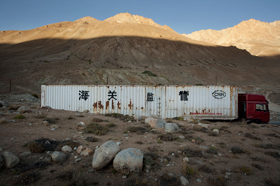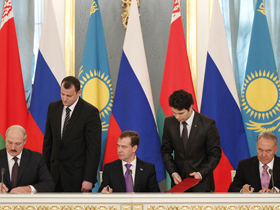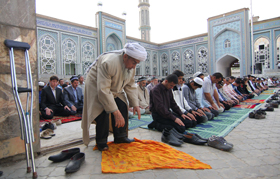Central Asia is presently a vital area for world politics. The 9/11 acts of terror in New York and Washington showed that the collapse of states in this region as they lose control over their national borders may have serious repercussions for other parts of the world. In addition, the involvement of major world powers (China, Russia, the US, India, Pakistan) in regional affairs suggests that the borders of Central Asian countries may be changed to meet the interests of these outside players. How might national borders in the region change in one hundred years?
Mobile Borders in Central Asia
Contemplating future borders in Central Asia is not an easy task: for one thing, the external boundaries of this region, vis-à-vis the other regions of the world, have never been clearly defined. In terms of classical 19th century geography, Central Asia is the region of the inland (land-locked) confluence of rivers stretching from China and India to the Middle East.
In Soviet times, the concept of Central Asia was limited to the region surrounding Mongolia, and was distinct from Middle Asia (which did not include Kazakhstan). In terms of modern international relations, Central Asia is a self-appellation that emerged with the disintegration of the USSR, and incorporated five post-Soviet republics (Kazakhstan, Kyrgyzstan, Tajikistan, Turkmenistan and Uzbekistan). There are, however, alternative definitions. For example, the Greater Central Asia favored by the US may also include Afghanistan and even parts of Pakistan. There are numerous culturally, historically, geo-economically and geopolitically-influenced names given to the region. The way they interact reflects the symbolic and ideological dimension of the “new Great Game”, whose players, the great powers, battle for regional influence [1].
Two kinds of factor are of decisive importance for the changing borders in the region in the next hundred years: external factors (world politics, particularly those pursued by the great powers) and internal factors (structural changes in Central Asian countries). Given this, several border change scenarios are possible.
The Great Game and Future Borders in Central Asia
We shall first consider the external factors. The geopolitical “centrality” of Central Asia [2] and the regional nations’ need for outside aid have resulted in extensive interference by the great powers (China, Russia, the US, EU countries, India, etc.). And although this trend is likely to continue into the future, it does not have to lead to competition among great powers (the “new Great Game”). It is quite possible that they will collaborate in addressing key regional issues (such as terrorism, failed states or drug trafficking). The region will continue to be important as a source of energy, and a potential new trade crossroads between the East and West as well as the North and South of Eurasia.
Several possible scenarios can be conceived as a result of interference in Central Asian affairs by outside powers. In the cooperation scenario where regional development is promoted, the present national borders will persist. If more intense competition between the great powers results in a balance of power, e.g., between China (or China and Russia in a “bloc”) and the West, this will not impact on borders either, because the regional leaders will remain balanced between the opposing forces as part of their now well-established “multi-vector policies”.
However, should a certain combination of factors arise, China might gain full control of Central Asia (Scenario 1 – “the Sino-centric world”). Some of these factors include the complete withdrawal of the US from Afghanistan and Central Asia in 2014–2020; a protracted economic crisis in Europe; and demographically induced “stagnation” in Russia, resulting in the failure of Eurasian integration. China would gain control gradually, first through economic instruments and unobtrusive political influence, then adding “soft power” and spreading its language and culture among the elite members of society. China would be in a position to find a common language both with secular elites in the region and, aided by its allies in Pakistan, with Islamist extremists, channeling their energy against Western influences.
As early as 2015, the Shanghai Group’s “common market”, established despite Russia’s reluctance, will trigger a process of intense economic and political integration. It is expected to cover Central Asia and the Asian regions of Russia, and bring in a number of associated members across the post-Soviet territories, e.g., the European part of Russia, Armenia and Belarus. The result, in 60 to 100 years, will be an expanded China. Historically, the borders of the Tang Empire were much farther west than today, and the famous Chinese poet Li Po was born in present-day Kyrgyzstan, then a Chinese province. Furthermore, the current borders of Central Asian countries with China have already changed since Soviet times, as their demarcation within the framework of the “Shanghai Process” shifted the borders in China's favor.
Only ten to twenty years ago, such an outcome of the New Great Game would have been unthinkable. The rebuilding of the USSR or of the Russian Empire seemed much more likely. And although today this possibility has not entirely vanished, it is rapidly diminishing year after year. Should Russia be able to rapidly create an efficient and enticing model of socioeconomic development, Scenario 2 could be possible, with the reintegration of post-Soviet territories (based, for example, on the Eurasian economic integration). Then, borders may eventually disappear, leading to a return to the circumstances of the 19th-20th centuries.
In the 1990s, yet another option for changing borders was suggested. This option stemmed from the idea of a Central Asian integration emulating the EU. However, so far all attempts by Central Asian nations to foster intraregional cooperation (through such regional entities as the Central Asian Economic Community or Organisation for Central Asian Cooperation) have been unsuccessful. Some of the issues between nations (most importantly, those pertaining to water, energy and the environment) seem rather difficult to resolve within the next few decades. The current tensions between Uzbekistan and Tajikistan, for example, will remain, as they are the result of systemic factors. However, purely as an intellectual exercise, one can try to imagine a successful Central Asian integration, in some thirty years’ time, resulting from the successful management of trans-border rivers. This could eventually lead to a Central Asian Union, similar to the EU in its structure. One can even try to imagine its enlargement, along the lines of the Great Central Asia for which the US is lobbying, incorporating Afghanistan or even Pakistan and Iran, after liberal reforms by the latter (Scenario 3 – “Central Asian Integration”). Some smaller-scale integration scenarios are also possible, such as through the economic union of Kazakhstan and Kyrgyzstan, or through a military and political alliance centred on a stronger Uzbekistan.
There could be yet another outcome to this “New Great Game”. Developments in Afghanistan may combine with the rise of Islamic extremism and, given the socioeconomic and demographic troubles and intertribal political conflicts, lead to Scenario 4 – a “caliphate” (one likely to incorporate only some of Central Asia, in particular the Fergana Valley).
Regional Weaknesses and Future Borders
It is now time to discuss internal factors. The regional countries, evolved from former Soviet republics post-1991, are characterised by significant unconventional security challenges (terrorism, religious extremism, drug trafficking). Some of the countries (in particular, Kyrgyzstan and Tajikistan) are quite fragile and teeter on the brink of becoming “failed states”. These new challenges are significantly reinforced by the immediate presence of Afghanistan, a classic “failed state” of the late 20th - early 21st century. All these tendencies suggest that, given time, the system of national borders in the region will change.
Within Central Asia, the present-day borders came into being with the emergence of new independent states, while retaining the existing complex and conflict-prone ethnic and sub-ethnic structures. It is an established fact that the existing borders and the identities of the nations have, to a large extent, been brought about artificially by the Bolsheviks during the 1920-1930 ethnic and territorial demarcations. They ignored zhuzhes and tribes (among the Kazakhs and Turkmens), regional identities (among the Kyrgyz, Uzbeks and Tajiks) and super-tribal identities (“Sarts”, “Turks”, Muslims); disregarded old political and administrative borders (Bukhara, Khiva and Kokand Khanates) and linguistic borders (Tajik-speaking Uzbeks in Samarkand and Uzbek-speaking residents in Tajikistan), and even the natural borderlines of oases (the Fergana Valley that used to be part of the Kokand Khanate; the lower Amu Darya Valley that once belonged in the Khiva Khanate, etc.). This brought about serious clan-tribe as well as clan-regional conflicts in the new independent states. There is no reason to believe that these will be successfully overcome even given decades. In this respect, the region is comparable to Africa, which has similar issues with the artificial demarcation of borders and the resulting tensions that tend to grow rather than abate. The latest example is Southern Sudan, a state that emerged recently based on the old tribal borderlines.
However, some new national identities have successfully evolved. All of the post-Soviet Central Asian countries have acquired ethno-national identities, while Kazakhstan now has a national (Kazakh) identity. The existence of the Kazakhs (or Kazakhstanis), the Kyrgyz, Uzbeks, Turkmens and Tajiks, with their identities, independence, statehood and associated territory, is a fact established and affirmed by their Soviet as well as post-Soviet history. It is unlikely that in the near future anyone could “undo” these facts of life by trying to establish a caliphate, reconstruct the USSR or build any other imperial super-national entity. Any such attempt would face unanimous rejection by the overwhelming majority of the population.
Indeed, developments in Central Asia in the coming century will demonstrate the interplay of two dynamic internal factors: the established national identities on the one hand, and their intrinsic contradictions caused by sub-ethnic and sub-regional entities on the other.
In actual fact, all of the above appear to point to the plausibility of Scenario 5 – “Complete Collapse”. In the most extreme eventuality, the region, and in particular, its southern part, may even imitate the course of events followed by Afghanistan.
We cannot also rule out some “partial” collapse of states, particularly “fragile states”, which is the most probable alternative version of Scenario 5. In the 1990s, there were a lot of debates about state failure in Central Asia. The civil war in Tajikistan provoked a lot of speculation about its imminent collapse. Clashes in Gorno-Badakhshan in the summer of 2012 have only poured oil on the flames. The profound geopolitical schism between the south and the north keeps the possible break-up of Kyrgyzstan under discussion (as the Bishkek government has only symbolic control over the southern areas, and in particular over the city of Osh).
While Uzbekistan, Turkmenistan and Kazakhstan are usually deemed more stable states, Islamic terrorism in Fergana Valley, inter-clan frictions across the country, and territorial claims to Tajik-speaking Samarkand (among other things, the native land for the incumbent clan in Uzbekistan, with President Karimov at its head) by Tajikistani elites have frequently caused speculation about the break-up of Uzbekistan. The Turkmenistan opposition, too, circulates rumours about the possible future secession of oil and gas-rich provinces inhabited by the Yamoud tribe, with eventual establishment of the state of Yamoudistan. Finally, even Kazakhstan, while demonstrating an exceptionally high degree of stability for the region, was often regarded in the Russian political discourse of the 1990s as a potential candidate for collapse. Such predictions were prompted by the dominance of Russian speakers in the northern provinces, some of whom (especially Cossacks) expressed separatist sentiments.
So far, none of these fears or predictions have come true, despite the obvious problems in the region.
Which Alternative Future is Most Probable?
In conclusion, given the real difficulty of analyzing any trends that extend across the scale of a century, and given the ongoing processes we presently observe, the most likely scenarios are 1 and 5. Indeed, since they do not contradict each other, they may well take place at the same time. In fact, the trend towards disintegration among some of the regional players may prompt China to intensify its interference in Central Asian affairs. The Sino-centric scenario may prove quite plausible given the strong position that China enjoys relative to other great powers with interests in Central Asia. The Complete Collapse scenario may be quite realistic for some of the less stable countries in the region, given the kind of socioeconomic and political issues they have to face.
Overall, in view of the significance of Central Asia for Russia, the above trends and scenarios should be sufficient cause for concern for the Russian political elite.
1. Kazantsev A.A. The Great Game with Unknown Rules: World Affairs and Central Asia. Moscow, MGIMO; Eurasia Legacy, 2008 (in Russian)
2. Frank A.G. The Centrality of Central Asia. Amsterdam: VU University Press, 1992.












